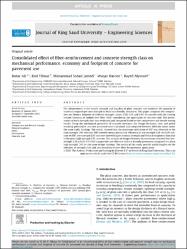Consolidated effect of fiber-reinforcement and concrete strength class on mechanical performance, economy and footprint of concrete for pavement use
Citation
Ali, B., Yilmaz, E., Sohail Jameel, M., Haroon, W. & Alyousef, R. (2021). Consolidated effect of fiber-reinforcement and concrete strength class on mechanical performance, economy and footprint of concrete for pavement use. Journal of King Saud University - Engineering Sciences. https://doi.org/10.1016/j.jksues.2021.09.005Abstract
The advancement in the tensile strength and ductility of plain concrete can minimize the quantity of materials required per unit strength to build eco-friendly structures. This paper compares the compressive and flexural behavior of different strength classes (C20, C30, and C45) of concrete with the varying volume fractions of hooked steel fiber (HSF) considering the application of concrete road. The performance of each strength class was evaluated and compared based on the compressive and tensile testing results. Using the mechanical properties of concrete mixtures; the design thickness, cost, and global warming potential of concrete pavement were calculated and compared between different mixes under the same traffic loadings. The results showed that the maximum utilization of HSF was observed in the high-strength C45, whereas HSF showed comparatively low efficiency in low-strength C20. At 0.25% volume of HSF, low strength C20 concrete showed higher residual strength and flexural toughness than that of the plain high strength C45 concrete. The analysis of design thickness of pavements revealed that low-strength C20 at 0.25–0.5% HSF can provide cost-effective and eco-friendly pavements compared to a plain high strength C45 for the same design loadings. The results of this study provide useful insights on the selection of strength class and concentration of steel fiber for pavement application.


















